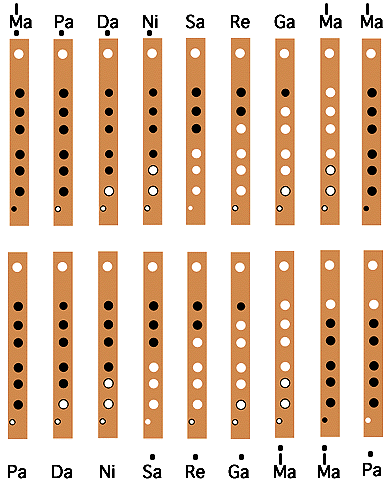Bansuri - Indian Bamboo Flute: Fingering Chart.
Reproduced here for educational purposes from Bansuri Player - David Philipson's Web Site.

In Indian music, the Sargam system corresponds to the European Solfege system's names of the notes.
Here is a chart which shows the names of the degrees of the Bilawal 'That' [ parent scale ] in Sargam and
the corresponding names of the degrees of the major scale in Solfege :
| 1 | Sadhjya | abbreviated as | Sa | corresponds to | Do |
| 2 | Reshab | abbreviated as | Re | corresponds to | Re |
| 3 | Gandhar | abbreviated as | Ga | corresponds to | Mi |
| 4 | Madhyam | abbreviated as | Ma | corresponds to | Fa |
| 5 | Pancham | abbreviated as | Pa | corresponds to | So |
| 6 | Dhaivat | abbreviated as | Dha | corresponds to | La |
| 7 | Nishad | abbreviated as | Ni | corresponds to | Ti |
A line below the note lowers the note by a half - step . This is known as a Komal swar : 
A vertical line above the note raises the note by a half - step :  . This is known as Tivra Ma.
. This is known as Tivra Ma.
A dot below the note means the note is in the register below middle Sa :
A dot above the note means the note is in the register above middle Sa :
The above chart shows the basic fingerings for the bansuri. This is for the Kalyan 'That', which corresponds to the Lydian mode in European music. [ A major scale with the fourth degree raised by a half - step.]
Sa [Do] is played with the first three finger holes closed.
On a bansuri with seven holes [as shown above] Tivra Ma [ ] in the middle and upper octave
can be fingered with all the finger holes closed or with all the finger holes open [ in the higher
octave the first finger hole is uncovered ].
] in the middle and upper octave
can be fingered with all the finger holes closed or with all the finger holes open [ in the higher
octave the first finger hole is uncovered ].
Shuddh [ lit.= pure ] Ma [ the unraised fourth degree ] and all other flattened notes [komal Re, komal Ga, komal Dha and komal Ni] are played by uncovering the necessary portion of the finger hole.
![]() For a printable Adobe Acrobat PDF Format Version of these instructions.
For a printable Adobe Acrobat PDF Format Version of these instructions.
For Easy to Follow Flutes
Call - Out. In PDF Format.
![]()